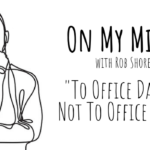How many active sellers do you serve?
200? 500? 800?
How do you decide how much “love” to give, to whom, and when?
Speaker, author, executive coach, and Olympic medalist, Paul Kingsman is a sought-after expert on how to be distraction-proof. He teaches financial services professionals the repeatable systems, processes, and verbiage required to successfully grow their businesses and achieve outstanding long-term results.
Paul knows the importance of keeping focused in life’s split seconds first hand: he trained for 13 years, to swim a 2 minute backstroke race at the Olympics, and won a medal by only four one-hundredths of a second!
As an Olympic medalist, Paul knows the principles and mind-set needed to succeed in a highly competitive environment. As a financial advisor, he understands the daily business realities of this industry. His experience enables him to equip audiences and coaching clients with practical solutions to overcome distractions, pursue their priorities, and increase their AUM.
His book, The Distraction-Proof Advisor: Gain Control, Work Smarter, Succeed Sooner, is available from Amazon.com.
Help Your Advisor Clients Service Their Clients More Effectively
For the advisor, segmenting their book into different service tiers is foundational to creating a scalable, manageable business.
If you’re working with advisors who have heard about segmenting their book but keep putting it off, now is the time for you to provide them with a template and help them take action.
Creating client service tiers is not a perfect science, but there are some guidelines you can provide advisors with that they will find helpful in applying to their book.
Where to Start
Advisors should begin by classifying their clients by Assets Under Management (AUM) dollar value. Then divide the clients into groups:
- The top 10 percent (highest AUM levels) of clients are in the A group
- The next 20 percent of clients are in the B group
- 40 percent are in the C group
- 30 percent are in D group
Their C and D groups should be the biggest, allowing room for growth in their A and B groups.
Delivery Frequency
Once these initial divisions are made, advisors need to decide how they will service the people in the various tiers. Here is an example for an advisor with 120 clients they have grouped as suggested above.
- If they intend to hold quarterly face-to-face review meetings with their 12 A clients, they would need to hold a review meeting with four clients each month.
- If they want to meet with their 24 B clients three times a year, split over two face-to-face meetings and one phone call review, they will need to schedule meetings with these clients once every four months. This translates to six meetings with clients from this group each month.
- If they want to meet their 48 C clients twice each year, once face-to-face and once by phone, they will need to average eight meetings per month with these clients.
- To have a review with their 36 D clients twice a year by phone, they will need to schedule six of these calls per month.
All up, the advisor would be looking to have 24 meetings, either in person or by phone, each month—that’s six each week, or more than one per day.
Is This Realistic?
At this stage, just like effective wholesalers, the advisor needs to focus on how many meetings they need to have each week and how realistic this is. They must remember that their clients don’t know how they’ve been ranked, so they’re not going to feel slighted. The advisor simply must have a way of tracking their clients to ensure they deliver the most effective service possible to keep their clients happy while also growing their own business and maintaining their own sanity and health.
How To Handle Changes
Placements will change over time. Perhaps a C client inherits assets that rank them in the middle of the advisor’s A group. The advisor doesn’t need to announce that they are suddenly changing their servicing tier; the advisor or their assistant simply begins scheduling their reviews a little more frequently.
This Takes Some Work
The process of segmenting their book might take the advisor several days, or even several weeks, but it is essential that they commit to it to be able to effectively manage their time and thoroughly connect with their clients! They should analyze where the bulk of their income is coming from and then create appropriate groups, where servicing them is relatively easy to monitor.
Remember to emphasize to them that it’s not an exact science, with hard and fast percentages or strict division lines. However, advisors must begin somewhere if their goal is to maintain (or regain) control of their business. By taking this step, they’ll begin to build their process and better manage existing clients, while also being able to devote time to business-building and administrative activities.
Once advisors follow through and complete this task, they typically excitedly say their business suddenly feels a lot more manageable. Many say it makes them feel like they can get their arms around their business, some for the first time in years.
What Will They Deliver?
Once client tiers and meeting frequency are in place, the advisor needs to begin building a list of specific deliverables and a way to track them. This is where the Client Service Matrix comes in.
DOWNLOAD THE CLIENT SERVICE MATRIX HERE
The matrix shows the key services advisors will provide to their clients at the designated times. Each client touch will be programmed into their schedule and tracked so they’ll know what’s coming and what’s been done. With good records and calendaring, advisors don’t have to worry because, much like great wholesalers, they’ll have a system to ensure their clients are being taken care of. This will also allow them to see when they can focus on other crucial activities that bring in new clients and uncover fresh assets.
Planning Client Meetings
Advisors use the matrix to decide what items are important for their clients and then determine when they will cover these. Not every item will be covered at every meeting. Each meeting (whether quarterly, every four months, or semiannually) will include a portfolio review, with other issues being addressed over time.
For instance, midyear meetings are a great time to discuss year-end gifting and communicate the benefits and intricacies of that with relevant clients. For clients approaching age 62, advisors should be prepared to address Social Security issues, helping their clients understand their options and maybe even calling the Social Security Administration with them on the line to make sure everything is clear.
You’re A Hero!
By coaching your advisor clients on the steps required to effectively segment their books and service their clients, you’re showing them just how much you completely understand their business and are also providing them with a tool to actually do it. This structure will ensure they are looking after all their clients thoroughly and put them in a better position to receive more referrals from their happy A clients. They’ll have you to thank for it.
Written by Paul Kingsman


 Lessons From Leaders #3: How Wholesalers Thrive in the Future with Cerulli Associates
Lessons From Leaders #3: How Wholesalers Thrive in the Future with Cerulli Associates On My Mind: Your Strategic Wholesaling Advantage
On My Mind: Your Strategic Wholesaling Advantage On My Mind: To Office Day or Not To Office Day?
On My Mind: To Office Day or Not To Office Day? On My Mind: What’s Next?
On My Mind: What’s Next?